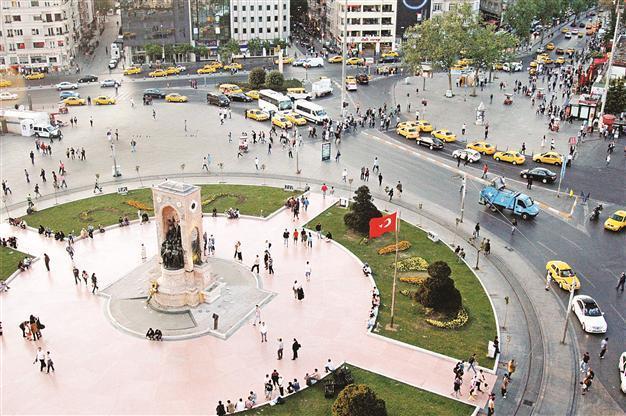Taksim’s transformation continues amid arts and culture scene’s alarm
ISTANBUL- Hürriyet Daily News

The main road off Taksim Square, İstiklal Street is only for pedestrians. Currently, the connections to İstiklal street are under condtruction dues to the the pedestrianization work. AP photo
Long criticized by residents, the controversial pedestrianization of Taksim Square is also drawing anger from luminaries in Istanbul’s cultural scene, who worry that the hastily made plans to transform the iconic square could greatly hurt art in Istanbul.
The pedestrianization work, which began Nov. 5 and includes boring tunnels for traffic beneath the square, will ensure that the way art is consumed in the city will change, according to Fırat Arapoğlu, a curator and art historian.
Amid globalization, authorities are primarily interested in converting Istanbul into a finance center, Arapoğlu said, adding that transforming Taksim was part of such a project and that the pedestrianization was part of a new style of making the area a public space. Newly built hotels, parking lots, and rebuilt, “historical” buildings are all evidence of this movement, he added.
“Artists’ studios will vanish and galleries will become venues that only focus on consumption rather than delivering information and focusing on art,” said Arapoğlu, adding that art initiatives and art walks could be terminated with the project. “So, as a result, people would just come to Taksim to see some exhibitions and buy some works and then leave. This means there will be no creation process.”
Earlier in October, around 1,000 people staged a protest against plans by Istanbul Metropolitan Municipality to pedestrianize the square. The Istanbul Chamber of City Planners says the project’s aim is in fact not to ease the traffic for pedestrians, but rather to give primacy to vehicles by creating five tunnels, which will make it very difficult for pedestrians to reach the square. Tayfun Kahraman, the head of the chamber, said the project had been designed entirely for vehicles and shopping malls; under the scheme, pedestrians will only have two choices to reach the square: The first is to walk in a single line on two sides of the street for nearly 100 meters, while the second is to climb the stairs from below ground where the square’s myriad bus lines will be rerouted, he said.
Galleries heading to Karaköy, TophaneKaraköy, which is also part of Beyoğlu Municipality, is also undergoing changes, increasingly becoming a new location for art galleries and a hip venue for art lovers. Newly established galleries in the area have expressed hopes about the changes. “Galleries are public institutions and, as such, must be accessible to people,” said Suzanne Egeran, owner of the Egeran Gallery. “By foot or by car is not as important as context. The character of the redevelopment will determine its impact on the galleries and the possibility for a meaningful exchange between the galleries and their audience.”
The newly established galleries have opted to choose large venues found in the area, with Egeran Gallery moving into a seaside location featuring a large exhibition space as well as a café, while Krampf Gallery, owned by Regis Krampf, also has a large venue founded in Tophane. Another space in the area, Gallery Mana, which was opened by Mehveş Arıburnu, an art patron who splits her time between Istanbul and London, provides a different example of the trend toward new large art galleries in Istanbul. According to Aslı Seven, who is in charge of Mana’s artist liaisons, the situation is a little bit different.
“Private space is getting its claw over public space and this is how we look at the Taksim project,” said Seven. The transformations would produce side effects for the galleries. Like Arapoğlu, Seven said she thought the trend would ensure galleries become more consumption-oriented venues. The trend will result in artists focusing on merely creating works that are designed to attract the attention of people who have more money to buy artwork, Seven said, adding that galleries would come to be seen as a provider for private collections. This may make it harder to attract different viewers to the gallery and open up to different communities, expunging art from society. “However, if the aim is to create [a place for art] and create value in terms of artistic events, these projects – such as Karaköy’s Galataport – may restrict our areas,” she said. While Istanbul’s art world is pessimistic , Mayor Kadir Topbaş has said residents will be grateful when the project is completed. “There are some habits that have caused traffic congestion in Taksim. But I believe this chaos will end soon.”
